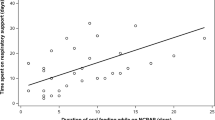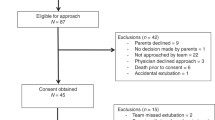Abstract
Objective:
To measure the effect of nasal continuous positive airway pressure (CPAP) on intestinal blood flow velocity responses to enteral feedings and left ventricular output (LVO).
Study Design:
Eighteen infants completed the study (birth weight 1793±350 g, gestational age 32.1±1.1 weeks). On the day infants were weaned from CPAP to room air, pre- and postprandial (0, 30, 60 and 90 min after feeding) mean velocity (MV), peak systolic velocity (PSV) and end diastolic velocity (EDV) were measured for one feeding given when receiving CPAP (‘on CPAP’), and for one feeding given after CPAP had been discontinued (‘off CPAP’). Preprandial LVO was measured before and after CPAP discontinuation.
Result:
MV and PSV were significantly lower when infants were on CPAP (P<0.05). Maximum postprandial MV, PSV and EDV occurred at 30 min when on CPAP and at 60 min when off CPAP. Preprandial LVO was similar when infants were on and off CPAP.
Conclusion:
CPAP administration affects pre- and postprandial intestinal blood flow velocity, which may impact tolerance to enteral feedings.
This is a preview of subscription content, access via your institution
Access options
Subscribe to this journal
Receive 12 print issues and online access
$259.00 per year
only $21.58 per issue
Buy this article
- Purchase on Springer Link
- Instant access to full article PDF
Prices may be subject to local taxes which are calculated during checkout



Similar content being viewed by others
References
Aly H, Milner JD, Patel K, El-Mohandes AA . Does the experience with the use of nasal continuous positive airway pressure improve over time in extremely low birth weight infants? Pediatrics 2004; 114: 697–702.
Meyer M, Mildenhall L, Wong M . Outcomes for infants weighing less than 1000 g cared for with a nasal continuous positive airway pressure-based strategy. J Paediatr Child Health 2004; 40: 38–41.
De Paoli AG, Morley C, Davis PG . Nasal CPAP for neonates: what do we know in 2003? Arch Dis Child Fetal Neonatal Ed 2003; 88: F168–F172.
Jaile JC, Levin T, Wung JT, Abramson SJ, Ruzal-Shapiro C, Berdon WE . Benign gaseous distension of the bowel in premature infants treated with nasal continuous airway pressure: a study of contributing factors. AJR Am J Roentgenol 1992; 158: 125–127.
Havranek T, Thompson Z, Carver JD . Factors that influence mesenteric artery blood flow velocity in newborn preterm infants. J Perinatol 2006; 26: 493–497.
Robel-Tillig E, Knupfer M, Pulzer F, Vogtmann C . Blood flow parameters of the superior mesenteric artery as an early predictor of intestinal dysmotility in preterm infants. Pediatr Radiol 2004; 34: 958–962.
Fang S, Kempley ST, Gamsu HR . Prediction of early tolerance to enteral feeding in preterm infants by measurement of superior mesenteric artery blood flow velocity. Arch Dis Child Fetal Neonatal Ed 2001; 85: F42–F45.
Walther FJ, Siassi B, Ramadan NA, Ananda AK, Wu PY . Pulsed Doppler determinations of cardiac output in neonates: normal standards for clinical use. Pediatrics 1985; 76: 829–833.
Reber KM, Nankervis CA, Nowicki PT . Newborn intestinal circulation. Physiology and pathophysiology. Clin Perinatol 2002; 29: 23–39.
Martinussen M, Brubakk AM, Vik T, Yao AC . Mesenteric blood flow velocity and its relation to transitional circulatory adaptation in appropriate for gestational age preterm infants. Pediatr Res 1996; 39: 275–280.
Van Bel F, Van Zwieten PHT, Guit GL, Schipper J . Superior mesenteric artery blood flow velocity and estimated volume flow: duplex Doppler US study of preterm and term neonates. Radiology 1990; 174: 165–169.
Maruyama K, Koizumi T . Superior mesenteric artery blood flow velocity in small for gestational age infants of very low birth weight during the early neonatal period. J Perinat Med 2001; 29: 64–70.
Coombs RC, Morgan MEI, Durbin GM, Booth IW, McNeish AS . Doppler assessment of human neonatal gut blood flow velocities: postnatal adaptation and response to feeds. J Pediatr Gastroenterol Nutr 1992; 15: 6–12.
Yanowitz TD, Yao AC, Pettigrew KD, Werner JC, Oh W, Stonestreet BS . Postnatal hemodynamic changes in very-low-birthweight infants. J Appl Physiol 1999; 87: 370–380.
Maruyama K, Koizumi T, Tomomasa T, Morikawa A . Intestinal blood-flow velocity in uncomplicated preterm infants during the early neonatal period. Pediatr Radiol 1999; 29: 472–477.
Carver JD, Saste M, Sosa R, Zaritt J, Kuchan M, Barness LA . The effects of dietary nucleotides on intestinal blood flow in preterm infants. Pediatr Res 2002; 52: 425–429.
Leidig E . Doppler analysis of superior mesenteric artery blood flow in preterm infants. Arch Dis Child 1989; 64: 476–480.
Van Bel F, Van Zoeren D, Schipper J, Guit GL, Baan J . Effect of indomethacin on superior mesenteric artery blood flow velocity in preterm infants. J Pediatr 1990; 116: 965–970.
Coombs RC, Morgan MEI, Durbin GM, Booth IW, McNeish AS . Gut blood flow velocities in the newborn: effects of patent ductus arteriosus and parenteral indomethacin. Arch Dis Child 1990; 65: 1067–1071.
Hoecker C, Nelle M, Poeschl J, Beedgen B, Linderkamp O . Caffeine impairs cerebral and intestinal blood flow velocity in preterm infants. Pediatrics 2002; 109: 784–787.
Lane AJP, Coombs RC, Evans DH, Levin RJ . Effect of caffeine on neonatal splanchnic blood flow. Arch Dis Child Fetal Neonatal Ed 1999; 80: F128–F129.
Pezzati M, Biagiotti R, Vangi V, Lombardi E, Wiechmann L, Rubaltelli FF . Changes in mesenteric blood flow response to feeding: conventional versus fiber-optic phototherapy. Pediatrics 2000; 105: 350–353.
Yao AC, Martinussen M, Johansen OJ, Brubakk AM . Phototherapy-associated changes in mesenteric blood flow response to feeding in term neonates. J Pediatr 1994; 124: 309–312.
Jeays AD, Lawford PV, Gillott R, Spencer PA, Bardhan KD, Hose DR . A framework for the modeling of gut blood flow regulation and postprandial hyperaemia. World J Gastroenterol 2007; 13: 1393–1398.
Matheson PJ, Wilson MA, Garrison RN . Regulation of intestinal blood flow. J Surg Res 2000; 93: 182–196.
Sidery MB, Macdonald IA, Blackshaw PE . Superior mesenteric artery blood flow and gastric emptying in humans and the differential effects of high fat and high carbohydrate meals. Gut 1994; 35: 186–190.
Gounaris A, Costalos C, Varchalama L, Kokori P, Kolovou E, Alexiou N . Gastric emptying in very-low-birth-weight infants treated with nasal continuous positive airway pressure. J Pediatr 2004; 145: 508–510.
Neu J, Zhang L . Feeding intolerance in very-low-birthweight infants: what is it and what can we do about it? Acta Paediatr Suppl 2005; 94: 93–99.
Hsu HS, Chen W, Wang NK . Effect of continuous positive airway pressure on cardiac output in neonates. Zhonghua Min Guo Xiao Er Ke Yi Xue Hui Za Zhi 1996; 37: 353–356.
Leech JA, Ascah KJ . Hemodynamic effects of nasal CPAP examined by Doppler echocardiography. Chest 1991; 99: 323–326.
Montner PK, Greene ER, Murata GH, Stark DM, Timms M, Chick TW . Hemodynamic effects of nasal and face mask continuous positive airway pressure. Am J Respir Crit Care Med 1994; 149: 1614–1618.
Pandit PB, Courtney SE, Pyon KH, Saslow JG, Habib RH . Work of breathing during constant- and variable-flow nasal continuous positive airway pressure in preterm neonates. Pediatrics 2001; 108: 682–685.
Author information
Authors and Affiliations
Corresponding author
Additional information
Conflict of interest
The authors have no conflicts of interest to declare.
Rights and permissions
About this article
Cite this article
Havranek, T., Madramootoo, C. & Carver, J. Nasal continuous positive airway pressure affects pre- and postprandial intestinal blood flow velocity in preterm infants. J Perinatol 27, 704–708 (2007). https://doi.org/10.1038/sj.jp.7211808
Received:
Revised:
Accepted:
Published:
Issue Date:
DOI: https://doi.org/10.1038/sj.jp.7211808
Keywords
This article is cited by
-
Enteral Nutrition Tolerance And REspiratory Support (ENTARES) Study in preterm infants: study protocol for a randomized controlled trial
Trials (2019)
-
Less invasive surfactant administration and complications of preterm birth
Scientific Reports (2018)
-
Regional tissue oxygenation in preterm born infants in association with echocardiographically significant patent ductus arteriosus
Journal of Perinatology (2011)
-
Splanchnic tissue oxygenation, but not brain tissue oxygenation, increases after feeds in stable preterm neonates tolerating full bolus orogastric feeding
Journal of Perinatology (2009)
-
Neonatal colour Doppler ultrasound study: normal values of abdominal blood flow velocities in the neonate during the first month of life
Pediatric Radiology (2009)



